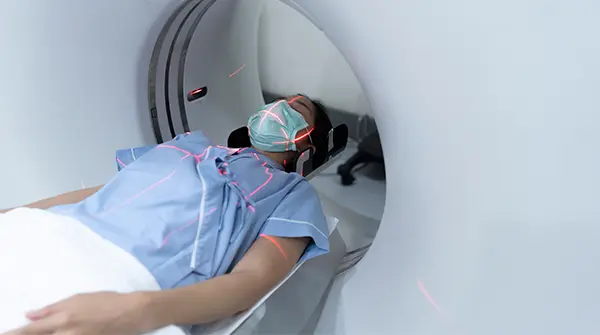
Like chemotherapy and surgery, radiation therapy is a type of cancer treatment. It most often uses X-rays or high-energy rays to treat cancer, shrink tumours before surgery, or kill cancer cells that are left after surgery. Your radiation oncologist will guide you and recommend radiotherapy tailored to your condition and the type of cancer you have.
Radiation therapy, medically known as radiotherapy, is a cancer treatment that destroys cancer cells and prevents their further growth. It is most often used in combination with surgery and chemotherapy. In radiation therapy, a machine directs high-intensity energy on tumours or cancer cells to damage the DNA of cancer cells.
The radiation used is called ionising radiation, as it forms ions. It creates charged particles and deposits high energy in the cells of the tissues it passes through. The main goal of radiation therapy is to deprive cancer cells of their multiplication (cell division).

There are primarily two types of radiation therapy: external radiation and internal radiation.
Radiation therapy is often given using machines outside the body. These machines move around your body without touching you. The procedure is painless, so you won’t feel anything during the session. It is called external beam radiation therapy (EBRT). It does not make you radioactive, so it is safe to be around others, including children.
Types of External Radiation Therapy
3D Conformal Radiation Therapy (3D-CRT)
Intensity-Modulated Radiation Therapy (IMRT)
Stereotactic Body Radiation Therapy (SBRT) or Stereotactic Ablative Radiation Therapy (SABR)
How It Works
Internal radiation therapy, or brachytherapy, delivers radiation inside the body. It targets cancer directly while protecting healthy tissues. Doctors place a small radioactive source near the tumour. It stays there for a set time, releasing radiation to destroy cancer cells. This therapy is often used for prostate, cervical, and breast cancer. Some implants are temporary, while others remain but lose radiation over time.
Types of Internal Radiation Therapy
Interstitial Radiation:
Intracavitary Radiation:
Systemic Radiation:
How does it work?
Doctors place a small radioactive source inside or near the tumour. It stays there for a set period, releasing radiation to kill cancer cells while limiting exposure to healthy tissue. Some implants are temporary, while others remain in the body permanently but lose radiation over time.
Radiation therapy is used to shrink tumours, destroy cancer cells, or relieve symptoms. Doctors may recommend it in the following cases:
As the main treatment for cancers that cannot be removed by surgery.
Radiation therapy is a precise, non-invasive treatment that targets cancer cells. It is delivered in two main ways:
The process is painless and performed as an outpatient procedure at CMRI Hospital, allowing patients to continue their daily activities.
Radiation therapy is a proven treatment with many benefits, including:
While radiation therapy is safe, some patients may experience mild side effects. These depend on the treatment area and dose.
Common side effects:
At CMRI Hospital, we are committed to providing advanced cancer care with compassion.
Here’s why patients trust us:
Your health and well-being are our top priorities. If you or a loved one needs radiation therapy in Kolkata, contact CMRI Hospital today for expert care and guidance.
No, radiation therapy itself is painless, but mild side effects may occur.
Yes, it is a well-established and safe treatment, with side effects managed by doctors.
Success depends on the cancer type and stage, but it is highly effective, especially in early stages.
Avoid processed foods, spicy foods, alcohol, and raw or undercooked meats.
It uses high-energy radiation to destroy cancer cells while minimising damage to healthy tissue.
© 2024 CMRI Kolkata. All Rights Reserved.